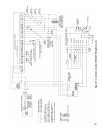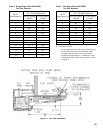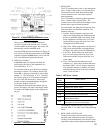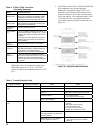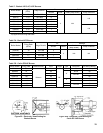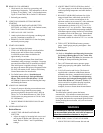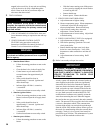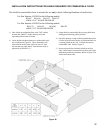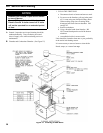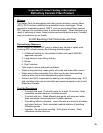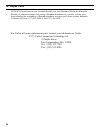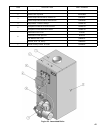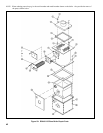
35
nozzle will compress when burner is on and will
expand when burner stops, causing oil to squirt from
nozzle at low pressure as burner slows down and
causing nozzle to drip after burner stops. Usually
cycling the burner operation about 5 to 10 times will
rid oil line of this air.
2. IF NOZZLE CONTINUES TO DRIP, repeat step
N.1. If this does not stop the dripping, remove cut
off valve and seat, and wipe both with a clean cloth
until clean. Then replace and readjust oil pressure.
If dripping or after burn persist replace fuel pump.
O. HINTS ON COMBUSTION
1. NOZZLES— Although the nozzle is a relatively
inexpensive device, its function is critical to the
successful operation of the oil burner. The selection
of the nozzle supplied with the RSA boiler is the
result of extensive testing to obtain the best ame
shape and efcient combustion. Other brands of
the same spray angle and spray pattern may be
used but may not perform at the expected level of
CO
2
and smoke. Nozzles are delicate and should
be protected from dirt and abuse. Nozzles are mass
produced and can vary from sample to sample. For
all of those reasons a spare nozzle is a desirable item
for a serviceman to carry.
2. FLAME SHAPE — Looking into the combustion
chamber through the ame plug hole, the ame
should appear straight with no sparklers rolling up
toward the top of the chamber. If the ame drags to
the right or left, sends sparklers upward or makes
wet spots on the combustion chamber, the nozzle
should be replaced. If the condition persists look
for fuel leaks, air leaks, water or dirt in the fuel as
described below.
3. FUEL LEAKS— Any fuel leak between the
pump and the nozzle will be detrimental to good
combustion results. Look for wet surfaces in the air
tube, under the ignitor, and around the air inlet. Any
such leaks should be repaired as they may cause
erratic burning of the fuel and in the extreme case
may become a re hazard.
4. AIR LEAKS— Any such leaks should be repaired,
as they may cause erratic burning of the fuel and in
extreme cases may become a re hazard.
There may be many possible causes of leaks in oil
lines such as:
a. Fitting leaks due to misared tubing or damaged
tting.
b. Fuel line leak due to crushed or bent tubing.
c. Filter connection leaks.
d. Tank connection leaks.
The following actions can eliminate air leaks:
a. Bleed pump as detailed in System Start-Up
Section of this manual.
b. Replace are ttings.
c. Replace oil supply line.
d. Repair oil lter leaks
e. Replace or repair tank ttings.
5. GASKET LEAKS— If 11.5% to 12.5% CO
2
with a
#1 smoke cannot be obtained in stack, look for air
leaks around the canopy seal. Such air leaks will
cause a lower CO
2
reading in the stack. The smaller
the ring rate the greater effect an air leak can have
on CO
2
readings.
6. DIRT— A fuel lter is a good investment.
Accidental accumulation of dirt in the fuel system
can clog the nozzle strainer and produce a poor
spray pattern from the nozzle.
7. WATER— Water in the fuel, in large amounts, will
stall the fuel pump. Water in the fuel pump, in
smaller amounts, will cause excessive wear on the
pump, but more importantly water does not burn.
It chills the ame, causes smoke, and allows un-
burned fuel to pass through the combustion chamber
and clog the ueways of the boiler.
NOTICE
CHECK TEST PROCEDURE. A very good test for
isolating fuel side problems is to disconnect the
fuel system and with a 24" length of tubing, re
out of an auxiliary ve gallon pail of clean, fresh,
warm #2 oil from another source. If the burner runs
successfully when drawing out of the auxiliary
pail then the problem is isolated to the fuel or fuel
lines being used on the jobsite.
8. COLD OIL— If the oil temperature approaching
the fuel pump is 40°F or lower, poor combustion
or delayed ignition may result. Cold oil is harder
to atomize at the nozzle. Thus, the spray droplets
get larger and the ame shape gets longer. An
outside fuel tank that is above grade or has fuel lines
buried in the ground above the frost line is a good
candidate for cold oil. The best solution is to place
the tank and oil lines in the ground below the frost
line.
9. HIGH ALTITUDE INSTALLATIONS
Typically, the rule to use for high altitudes is to
increase the air supply by 4% per each 1000 ft.
above 2000 ft. altitude from sea level. This means
that the air setting will have to be higher than the
calibration marks in proportion to the altitude. Use
instruments and set for 11.5 to 12.5% CO
2
.
10. START-UP NOISE — Late ignition is the cause of
start-up noises. If it occurs recheck for electrode
settings, ame shape, air or water in the fuel lines.
11. SHUT DOWN NOISE — If the ame runs out of
air before it runs out of fuel, an after burn with
noise may occur. That may be the result of a faulty
cut-off valve in the fuel pump, or it may be air



